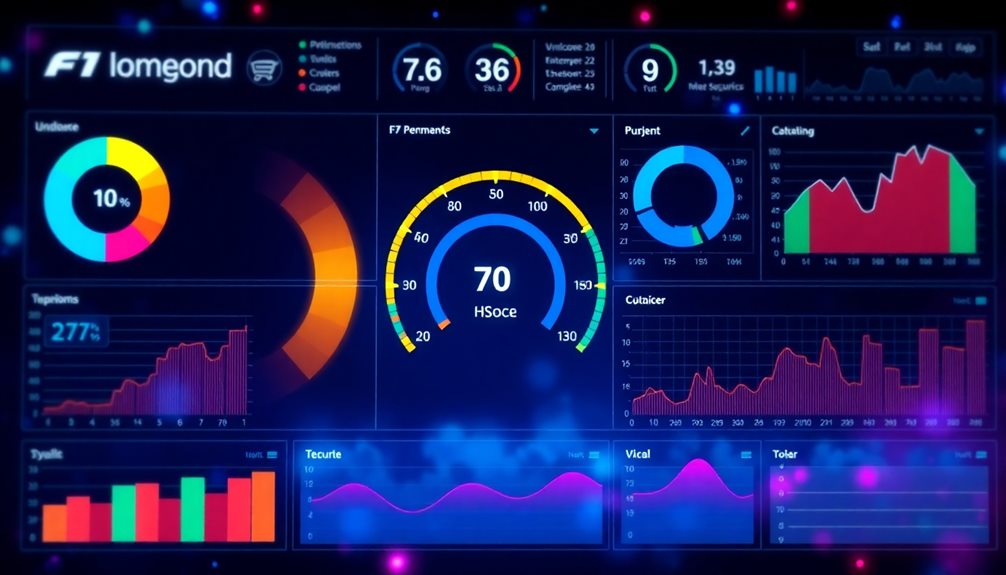Machine learning model optimization improves your algorithm's accuracy and performance by refining input-output relationships and tuning hyperparameters. You need to focus on aspects like learning rates, clusters, and regularization strength to get ideal results. Techniques such as grid search, random search, and Bayesian optimization can help you find the best combinations faster. Remember, metrics like the F1 score gauge model effectiveness, especially in classifications. Additionally, advancements like AutoML streamline these processes, making it easier for you. Stick around to uncover more strategies and insights that can elevate your machine learning projects.
Key Takeaways
- Machine learning optimization enhances model accuracy and minimizes errors through iterative refinement of input-output relationships.
- Hyperparameter tuning, including techniques like Grid Search and Bayesian Optimization, is crucial for achieving optimal model performance.
- Advanced optimization methods, such as Genetic Algorithms and AutoML, streamline hyperparameter tuning and model selection processes.
- Performance metrics like F1 Score provide insights into model efficacy, especially in class imbalance scenarios.
- Ongoing model management and performance monitoring are essential for maintaining effectiveness post-deployment.
Definition of Machine Learning Optimization

What does Machine Learning Optimization really mean? At its core, it's about improving the accuracy of machine learning models and minimizing errors. You'll use various techniques and optimization algorithms to guarantee your model can generalize well from training data to predict outcomes on unseen data.
This iterative process involves refining how your model interprets input and output relationships. As businesses increasingly integrate AI, the impact of automation becomes an essential factor in enhancing model performance.
An important aspect of optimization is the loss function. It quantifies the difference between what your model predicts and the actual values, guiding you to enhance model performance. By minimizing this loss, you're fundamentally fine-tuning your model to make sure it makes more accurate predictions.
To achieve ideal results, you'll often engage in hyperparameter tuning, adjusting specific parameters within your model to find the best configuration. This step is critical, as the chosen hyperparameters can greatly influence your model's effectiveness.
Importance of Hyperparameters

Hyperparameters play a significant role in shaping the performance of your machine learning models. These critical configurations, set before model training, include factors like learning rate and the number of clusters. Proper hyperparameter optimization is essential for achieving peak model performance, allowing your model to generalize effectively from training data to new data.
| Hyperparameter | Impact |
|---|---|
| Learning Rate | Affects convergence speed |
| Number of Clusters | Influences clustering quality |
| Regularization Strength | Controls overfitting |
| Batch Size | Impacts training time |
Over-optimized models might seem ideal but can become inflexible, failing to adapt to new data. On the other hand, under-optimized models may struggle to perform well on both training and unseen data. The iterative process of hyperparameter tuning requires you to compare model outputs against expected results and make adjustments based on accuracy assessments. By carefully refining these configurations, you guarantee that your model is not only effective but also robust in various scenarios, leading to improved accuracy and overall performance.
Techniques for Hyperparameter Tuning

When it comes to hyperparameter tuning, you'll want to explore various methods that can enhance your model's performance.
Techniques such as automation of security protocols can be paralleled in the optimization of hyperparameters to reduce human error in the tuning process.
You can choose between exhaustive search techniques, like grid search, and more advanced methods, such as Bayesian optimization.
Each approach has its strengths, and selecting the right one can make a significant difference in your results.
Tuning Methods Overview
Tuning your model's hyperparameters can greatly enhance its performance by fine-tuning configurations like learning rates and architectures. This optimization process is vital for achieving lower error rates and improving overall model performance.
To further support your optimization journey, maintaining a positive energy mindset can influence your success and attract the right opportunities, as emphasized in Abraham's Business Success Principles. You have several techniques at your disposal for hyperparameter tuning.
One common method is grid search, where you exhaustively evaluate combinations of predefined hyperparameter values. While thorough, it can be time-consuming.
Alternatively, random search samples configurations randomly, which can lead to quicker results without evaluating every possible combination.
For more advanced optimization, consider Bayesian optimization. This technique uses probabilistic models to intelligently explore hyperparameter spaces, often identifying best configurations with fewer evaluations.
Another innovative approach is genetic algorithms, which apply evolutionary principles—evaluating and recombining configurations over generations to enhance model performance.
Regardless of the method chosen, continuous tuning and validation through techniques like cross-validation are vital. This guarantees that your hyperparameters generalize well across different datasets, ultimately helping you avoid overfitting and enhancing your model's robustness.
Choose the tuning method that fits your needs best, and watch your model's performance soar.
Exhaustive Search vs. Gradient
Choosing the right technique for hyperparameter optimization can greatly impact your model's performance. You can opt for an exhaustive search or gradient descent, each with its own strengths and weaknesses.
An exhaustive search evaluates all possible combinations of hyperparameters, ensuring you find the best settings. However, this method can be computationally expensive, especially with larger datasets. If you're working with many hyperparameters, the sheer number of combinations may become unmanageable.
On the other hand, gradient descent offers a more efficient approach by minimizing the cost function iteratively. It updates parameters based on the gradient of the loss, making it particularly useful for complex models and large datasets. While it's faster, you need to be cautious with learning rates, as they can cause oscillations around minima or lead to getting stuck in local minima.
Ultimately, your choice between exhaustive search and gradient descent should depend on your specific use case, dataset size, and available computational resources. If you have a smaller dataset, exhaustive search might be feasible. For larger, more intricate models, gradient descent often proves to be the better option.
Advanced Optimization Techniques
While traditional methods like exhaustive search and gradient descent provide a foundation for hyperparameter optimization, advanced techniques can greatly enhance your model's performance.
One effective approach is the use of genetic algorithms, which mimic natural selection by evaluating and recombining hyperparameters through mutation and crossover operations. This flexibility allows you to explore hyperparameter spaces more effectively.
Another powerful method is Bayesian optimization, which utilizes probabilistic models to intelligently navigate these spaces. This technique often outperforms random or grid search methods, as it efficiently identifies promising hyperparameter settings.
Automated machine learning (AutoML) frameworks are increasingly integrating these advanced hyperparameter tuning techniques, streamlining your optimization process and considerably reducing the time it takes to achieve ideal model configurations.
Additionally, multi-fidelity optimization methods like Hyperband can allocate resources efficiently across various configurations, balancing exploration and exploitation to quickly find the best hyperparameters.
Exhaustive Search vs. Gradient Descent

When it comes to enhancing machine learning models, you can either rely on exhaustive search or employ gradient descent, each having its own strengths and weaknesses. Exhaustive search evaluates all possible hyperparameter combinations to find the ideal configuration. This method is intuitive and guarantees finding the best hyperparameters, but it's computationally expensive, especially for large datasets.
It's most effective on smaller datasets where high accuracy is a priority.
On the other hand, gradient descent is a first-order optimization algorithm that updates parameters iteratively based on the computed gradients. It focuses on minimizing the loss function efficiently, making it computationally efficient and suitable for larger datasets.
However, you need to be cautious, as gradient descent can struggle with local minima and saddle points. The selection of the learning rate becomes essential in these cases.
While exhaustive search can guarantee finding the global optimum, gradient descent often converges faster in high-dimensional spaces where exhaustive methods become impractical.
Ultimately, the choice between these optimization algorithms depends on your specific situation, balancing the need for accuracy with computational efficiency.
Advanced Optimization Techniques

When you explore advanced optimization techniques, evolutionary algorithms stand out for their ability to mimic natural selection in tuning hyperparameters.
You'll find that genetic algorithms are particularly useful for complex models, effectively pairing and scoring hyperparameters to enhance performance.
Evolutionary Algorithms Overview
Evolutionary algorithms represent a powerful class of optimization techniques inspired by natural selection and genetic principles. In these algorithms, potential solutions are treated as individuals within a population that evolve over generations.
You'll find that they typically involve essential processes like selection, crossover, and mutation, which allow for thorough exploration of the solution space. This is especially useful when tuning hyperparameters for machine learning models.
Genetic algorithms, a specific type of evolutionary algorithm, employ a fitness function to assess how well each solution meets the desired outcome. By evaluating performance through this function, the selection process naturally favors more ideal solutions, steering the algorithm toward better configurations.
One of the standout advantages of evolutionary optimization techniques is their effectiveness in traversing complex search spaces. Traditional methods often struggle to find global optima due to the pitfalls of local minima.
In contrast, evolutionary algorithms maintain diversity in the population, enhancing the chance of discovering superior solutions in challenging optimization landscapes. Overall, these techniques have proven invaluable in advancing machine learning, particularly in areas like neural networks and artificial intelligence applications.
Genetic Algorithms Applications
Genetic algorithms are revolutionizing how we approach optimization in machine learning, offering advanced techniques that go beyond traditional methods. These algorithms draw inspiration from natural selection, using processes like selection, crossover, and mutation to iteratively enhance hyperparameters in your models.
By encoding potential solutions as chromosomes, you can evaluate their fitness based on model performance metrics, enabling you to select the best candidates for the next generation.
When you apply genetic algorithms, you effectively navigate complex search spaces and avoid local minima, which often hinder traditional optimization techniques. This is especially beneficial in optimizing hyperparameters like learning rates, regularization strengths, and even neural network architectures.
As a result, you can achieve improved accuracy and reduced error rates in your machine learning models.
The versatility of genetic algorithms makes them suitable for diverse applications, from fine-tuning deep learning models to optimizing parameters in reinforcement learning tasks.
Performance Metrics: F1 Score

Understanding the F1 score is vital for effectively evaluating classification models, especially in scenarios where class imbalance is a concern. The F1 score combines precision and recall into a single metric, calculated as F1 = 2 * (Precision * Recall) / (Precision + Recall). This formula provides a balanced view of model performance, particularly when false positives and false negatives can skew the results.
Ranging from 0 to 1, an F1 score of 1 indicates perfect precision and recall, while a score of 0 signifies the worst performance. This makes the F1 score particularly valuable in classification tasks like healthcare and fraud detection, where accuracy alone can be misleading.
When dealing with multi-class situations, you can adapt the F1 score by calculating micro or macro averages, maintaining its relevance across various classification problems.
However, it's important to recognize its limitations; the F1 score doesn't account for true negatives and may prioritize recall over precision. As a result, you should consider additional metrics like ROC-AUC and Matthews Correlation Coefficient for a more thorough evaluation of your model's performance.
Effective Machine Learning Deployment

After evaluating model performance through metrics like the F1 score, the next step is guaranteeing that machine learning models are effectively deployed in real-world scenarios. Effective deployment not only minimizes risks but also enhances your understanding of how models impact business outcomes. Solutions like Seldon can accelerate your shift from proof of concept to production by 85%, which is essential for optimization.
Here's a quick overview of key aspects for effective deployment:
| Aspect | Importance |
|---|---|
| Model Management | Guarantees continuous monitoring and updates for performance. |
| Risk Mitigation | Minimizes potential pitfalls during deployment. |
| Performance Monitoring | critical for maintaining model efficacy over time. |
| Training and Support | Ongoing education through IQ Sessions helps your team adapt. |
| Specialized Tools | Tools like the LLM Module optimize deployment of Generative AI. |
Role of Seldon Solutions

In the domain of machine learning optimization, Seldon Solutions plays a pivotal role in transforming theoretical models into practical, scalable applications. By notably accelerating the shift from proof of concept (POC) to production by 85%, Seldon enhances your understanding of model impacts during deployment.
This efficiency is essential for businesses aiming to improve their models quickly.
Here's how Seldon Solutions supports your model optimization efforts:
- Seldon Core+Deploy: Facilitates scaling for enterprises and provides robust support for machine learning operations (MLOps).
- LLM Module: Aids in deploying and managing Generative AI applications, allowing for training deep, accurate models.
- IQ Sessions: Offers in-depth training and knowledge sharing, ensuring you can effectively utilize machine learning models in your operations.
- MLServer: A lightweight inference server that optimizes deployment strategies for your machine learning models.
Future Trends in Optimization

As machine learning continues to evolve, several key trends are shaping the future of optimization. One significant direction is the integration of advanced optimization algorithms such as automated machine learning (AutoML) and neural architecture search.
These innovations make hyperparameter tuning and model selection processes more efficient, allowing you to focus on learning rates that yield the best results.
The rise of explainable AI (XAI) is also significant. You'll find optimization techniques increasingly tailored to enhance model interpretability, ensuring transparency in decision-making.
This is essential as stakeholders demand clarity in automated systems.
Additionally, federated learning is gaining traction, enabling decentralized model training while preserving data privacy.
You can optimize models without moving sensitive data, making it a valuable approach in today's data-sensitive landscape.
Frequently Asked Questions
How Do You Optimize a Machine Learning Model?
To optimize a model, you'll adjust key parameters, test various configurations, and monitor performance. Use techniques like grid search or advanced methods to streamline the process, ensuring your model improves accuracy and minimizes errors effectively.
What Is Optimization Technique in Machine Learning?
Optimization techniques involve adjusting parameters to achieve better performance. You'll typically use algorithms like Gradient Descent or Adam, and apply methods like grid search for fine-tuning configurations, aiming for greater accuracy and efficiency in results.
What Is Optimization Theory in Machine Learning?
Imagine traversing a winding path; optimization theory in machine learning helps you find the best route. It focuses on minimizing or maximizing objective functions, guiding your model to improve performance and reduce errors effectively.
What Is the Best Optimization Algorithm for Machine Learning?
When choosing the best optimization algorithm, consider your specific task. Adam's adaptive learning rates excel in many scenarios, while SGD with momentum can boost convergence. Experiment with various methods to find what works best for you.
Conclusion
In the domain of machine learning, balancing optimization with deployment is essential. While fine-tuning hyperparameters can elevate your model's performance, it often requires patience and precision. Conversely, rushing to deploy without proper optimization can lead to disappointing results. As you navigate these complexities, remember that leveraging advanced techniques and metrics like the F1 score can make all the difference. Embrace the future trends in optimization and watch your models thrive in real-world applications, ensuring success in your endeavors.









